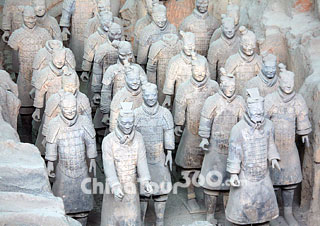 Terracotta Warriors and Horses
Terracotta Warriors and Horses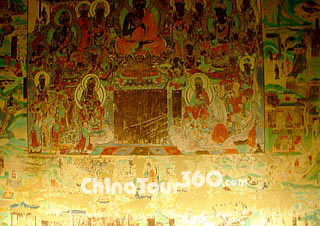 Murals in Mogao Caves
Murals in Mogao Caves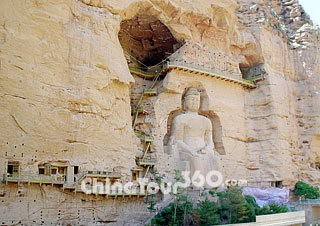 Bingling Temple, Gansu
Bingling Temple, Gansu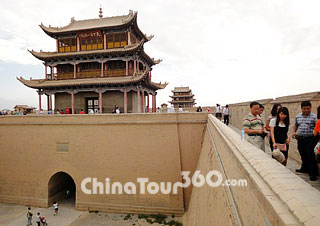 Jiayuguan Great Wall
Jiayuguan Great Wall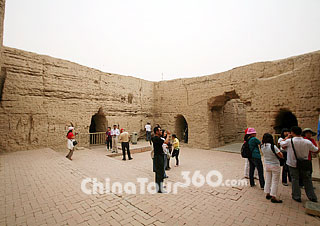 Jiaohe Ruins in Turpan, Xinjiang
Jiaohe Ruins in Turpan, Xinjiang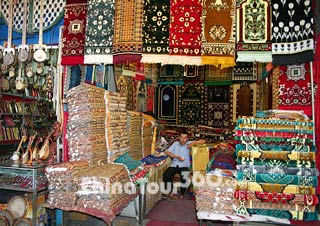 A Bazaar in Kashgar, Xinjiang
A Bazaar in Kashgar, Xinjiang
The Silk Road is a general term that once comprised a series of ancient trade routes connecting China with Asia, Africa and Europe. The earliest silk road was the route by which Zhang Qian took a diplometic trip to the west during the Western Han Dynasty (206BC - 24AD). As an important link between the Eastern and Western worlds, it greatly improves the in-depth exchange of politics, economics and culture among countries along the route. The four great inventions by the Chinese (namely paper, printing, compass and gunpowder), silkworm raising and silk weaving, tea and china have also become accessible to other parts of world. At the same time, Buddhism, Nestorianism, Islam, music, and astronomy were introduced to China.
It can be divided into two major routes: by land and by sea. The main inland routes prospered during the Han Dynasty (206 BC - 24 AD) and then declined during the Ming Dynasty (1368 - 1644). The route, which was over 7,000 kilometers (4,943.6 miles) long, is widely considered to start from Chang'an (today's Xian, China) traverse Gansu and Xinjiang, and extend westward to the Mediterranean area. Interestingly, the starting points changed as the political centers of the following dynasties also changed, including Luoyang , Datong, Kaifeng, and Beijing. The road by land consisted of three branches:
![]() Northern Branch: Chang'an (Xian) - Weihe River - Guo County (Baoji) - Yan County (Long County) - Liupan Mountain - Duli River - Jingyuan - Guzang (Wuwei)
Northern Branch: Chang'an (Xian) - Weihe River - Guo County (Baoji) - Yan County (Long County) - Liupan Mountain - Duli River - Jingyuan - Guzang (Wuwei)
![]() Southern Branch: Chang'an - Longguan Pass - Shanggui (Tianshui) - Didao (Linzhao) - Baohan (Hezhou) - Yongjing - Xining - Dadoubagu (Piandukou) - Zhangye
Southern Branch: Chang'an - Longguan Pass - Shanggui (Tianshui) - Didao (Linzhao) - Baohan (Hezhou) - Yongjing - Xining - Dadoubagu (Piandukou) - Zhangye
![]() Middle Brance: Chang'an - Longguan Pass - Shanggui - Longshan Mountain - Jincheng County (Lanzhou) - Wuqiaoling Range - Guzang
Middle Brance: Chang'an - Longguan Pass - Shanggui - Longshan Mountain - Jincheng County (Lanzhou) - Wuqiaoling Range - Guzang
The routes by sea arose in the Qin Dynasty (221 BC - 207 BC), flourished in the Song Dynasty (960 - 1279) and the Yuan Dynasty (1271 - 1368), and fell into decay during the middle Ming Dynasty. The principle route began in Guangzhou , Yantai, Yangzhou, Ningbo, and Quanzhou along with other coastal cities, via the Indian Ocean, the Red Sea, and finally reached the Mediterranean. The sea route consisted of three branches:
![]() Eastern Branch: Chinese ports - Korea and Japan
Eastern Branch: Chinese ports - Korea and Japan
![]() Southern Branch: Chinese ports - Southeast Asia
Southern Branch: Chinese ports - Southeast Asia
![]() Western Branch: Chinese ports - South Asian, Arabic and East African countries
Western Branch: Chinese ports - South Asian, Arabic and East African countries
After several centuries of disregard, the once dormant road is again springing to life. Tourists can explore the ancient historical sites, enjoy the gorgeous scenery along the route and appreciate mysterious attractions, such as Mogao Caves in Dunhuang and the Yumenguan Pass which was considered an important pass of the trade route. This centuries-old, international trade route awaits your adventurous undertaking.
![]() Recommended China Silk Road Tour Itineraries:
Recommended China Silk Road Tour Itineraries:
Silk Road Tour: 14 Days to Beijing, Urumqi, Kasghar, Urumqi, Turpan, Dunhuang, Xian and Shanghai
Silk Road Adventure: 22 Days to Beijing, Urumqi, Korla, Kuqa, Aksu, Kashgar, Hetian, Minfeng, Korla, Turpan, Dunhuang, Xian and Shanghai
Silk Road In-depth Tour: 20 Days to Beijing, Xian, Xining, Lanzhou, Xiahe, Lanzhou, Wuwei, Zhangye, Jiayuguan, Dunhuang, Turpan, Urumqi and Shanghai







